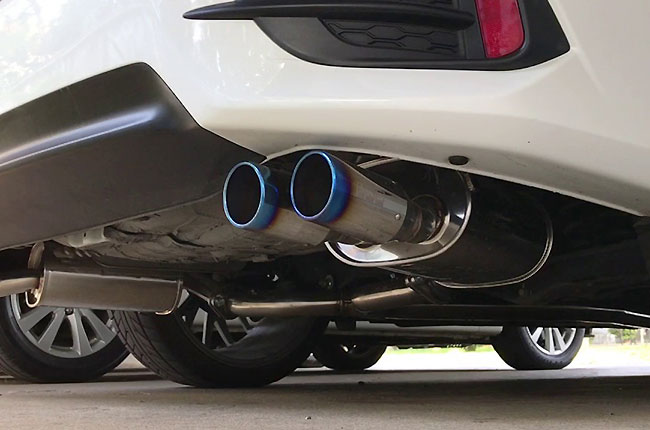
Understanding Aftermarket Exhaust Systems
Upgrading your vehicle’s exhaust system is a popular modification choice among automotive enthusiasts. Not only can it enhance the performance and sound of your car, but it also offers aesthetic appeal. With a wide array of aftermarket exhaust systems available, choosing the right one can be daunting. In this guide, we’ll explore the various types of aftermarket exhaust systems to help you make a better informed decision in your modification journey.
Disclaimer
Before diving into aftermarket exhaust upgrades, it’s crucial to understand the legal implications. Different regions have regulations regarding exhaust modifications, including noise levels, exhaust size/dimensions and emissions compliance. Always ensure that any modifications you make comply with local laws and regulations.
1. Axle-Back Exhaust Systems
Axle-back exhaust systems are the most straightforward type of aftermarket exhaust upgrade. They replace the section of the exhaust system from the rear axle to the exhaust tips. While they generally offer minimal performance gains, axle-back systems primarily focus on enhancing the exhaust note and improving aesthetics. They’re a popular choice for enthusiasts who want a deeper, more aggressive sound without breaking the bank.
Check Out: How to Modify Your Car on a Budget
2. Cat-Back Exhaust Systems
Cat-back exhaust systems replace everything from the catalytic converter back to the exhaust tips. By eliminating restrictive factory components and optimizing exhaust flow, cat-back systems offer noticeable performance improvements in addition to enhanced sound. They’re a practical choice for enthusiasts seeking a balance between improved performance and a more assertive exhaust tone.
3. Header-Back/Full Exhaust Systems
Header-back exhaust systems replace the entire exhaust system, including the headers or exhaust manifolds. While they’re the most complete and expensive option, header-back systems provide the greatest potential for performance gains. By optimizing exhaust flow from the engine’s cylinders to the exhaust tips, they can unlock significant increases in horsepower and torque. However, due to their complexity and cost, they’re typically purchased by serious performance enthusiasts or track-focused builds.
4. Turbo-Back Exhaust Systems
Turbo-back exhaust systems are specifically designed for turbocharged vehicles. They replace the exhaust system from the turbocharger outlet to the exhaust tips, optimizing exhaust flow and reducing backpressure. By improving turbo spool-up and reducing turbo lag, turbo-back systems can enhance throttle response and overall performance. Additionally, they often produce a more pronounced exhaust note, further enhancing the driving experience for turbocharged vehicle enthusiasts.
Pros of an Aftermarket Exhaust System
Enhanced Performance:
Aftermarket exhaust systems are designed to reduce back pressure and optimize exhaust flow, resulting in increased horsepower and torque. It is also worth mentioning that many aftermarket exhaust systems will weigh less than the heavy factory system which aids in weight reduction increasing overall performance and handling even more.
Improved Sound:
Many enthusiasts are drawn to aftermarket exhaust systems for their ability to produce a more aggressive and sporty exhaust note. Be tasteful and ensure the exhaust system you purchase is in good condition and good quality for the best sound.
Customization:
Aftermarket exhaust systems offer a wide range of options for customization, allowing enthusiasts to tailor their vehicle’s exhaust characteristics to their preferences. Through the use of formable steel tubing, enthusiasts and car manufacturers are able to build a highly reliable exhaust system that is also bespoke to each car or engine setup they decide to pair it with. Commonly exhausts are customized to look and sound the way you desire however that be.
Cons of an Aftermarket Exhaust System
Noise Levels:
While many enthusiasts appreciate a louder exhaust note, aftermarket exhaust systems can sometimes produce excessive noise levels that may be undesirable for daily driving or legal compliance.
Cost:
Depending on the type and brand, aftermarket exhaust systems can be relatively expensive, especially for complete systems like header-back or turbo-back setups.
Installation Challenges:
Installing an aftermarket exhaust system may require specialized tools and expertise, or professional installation, adding to the overall cost and complexity.
FAQ
1. What materials are aftermarket exhaust systems made of?
- Stainless Steel: Offers durability, corrosion resistance, and a polished appearance.
- Aluminized Steel: Provides cost-effectiveness but may be prone to corrosion over time.
- Titanium: Lightweight and corrosion-resistant, ideal for high-performance applications but comes at a premium price.
2. How do aftermarket exhaust systems improve performance?
- Reduced Exhaust Backpressure: Enhances engine breathing and scavenging, resulting in increased horsepower and torque through.
- Enhanced Exhaust Flow: Minimizes restrictions in the exhaust system and often widens the pipes also, improving engine efficiency and responsiveness.
- Weight Reduction: Lightweight materials and often smaller resonators/mufflers contribute to overall vehicle weight reduction, enhancing performance and handling.
Conclusion
Investing in an aftermarket exhaust system is a rewarding way to customize your vehicle’s performance and sound. By understanding the different types available and their respective benefits, you can choose the right exhaust system to suit your preferences, budget and driving needs. Remember to consider factors such as legality, material quality, and compatibility with your vehicle before making a purchase. With the right exhaust upgrade, you’ll elevate your driving experience and are sure to stand out on the road.
If you have any questions regarding vehicle modification feel free to reach out to [email protected] or check out more of my articles at 74Customs.
With a solid foundation in technology, backed by a BIT degree, Lucas Noah has carved a niche for himself in the world of content creation and digital storytelling. Currently lending his expertise to Creative Outrank LLC and Oceana Express LLC, Lucas has become a... Read more